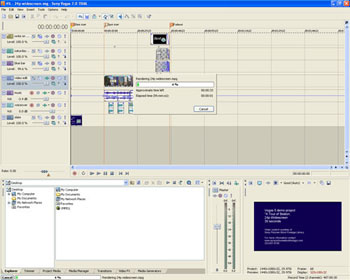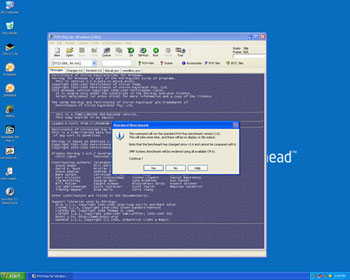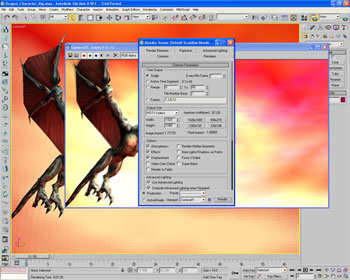Quad Cores: Intel Kentsfield Preview
by Anand Lal Shimpi on September 28, 2006 7:00 PM EST- Posted in
- CPUs
Kentfield Performance
Updated: We initially had a flawed equation for determining percentage differences on the time-based benchmarks. When higher scores are better, it is easy to state that something is a certain percentage faster. For timed tasks, the proper terminology would be how much longer the slow machine takes, or alternately what percentage of the time it would take the faster machine to complete the same task. The percentages now represent an advantage for POV-Ray, PCMark05, and 3DMark06 CPU, while in DivX, Sony Vegas and 3dsmax 8 the percentages are how much longer the X6800 takes. Hopefully, that will help make things clear (as mud).
The DivX performance test is similar to the encoding test we run for our usual CPU reviews, although Intel runs it with higher quality settings so that it stresses the CPU more. Here, the lower clocked, quad-core Core 2 Extreme QX6700 can encode the video in 72.6% of the time of the X6800, or put another way the X6800 takes 37.7% longer. Assuming linear frequency scaling, quad-cores could complete the video encoding in around 66% of the time as dual cores, or dual cores would take 51.4% longer in DivX encoding.
Sony's Vegas application is an Adobe Premier-like application, and rendering video in it is a highly multi-threaded workload. We see that the X6800 takes 50.9% longer than the QX6700. Were we to have equal clock speeds, dual core would take around 66% longer.
Using the POV-Ray multi-threaded beta we ran the application's built in benchmark and noticed a tremendous increase in performance. The QX6700 is over 80% faster than the X6800 thanks to a doubling in the number of cores. Estimating performance scaling at equal clock speeds again, we should get nearly twice the performance with four cores as with two cores, a 98% performance increase.
The 3dsmax 8 test is simply rendering a single frame at high resolution, and the X6800 takes 63.3% longer than the QX6700. Accounting for clock speed differences, dual cores should take about 80% longer than quad cores.
PCMark05's overall score gives you more of an idea of what you can expect for workloads that aren't highly multithreaded, where there's a reduction in performance thanks to the lower clock speed. Looking at the CPU test in specific, there's an advantage to the quad-core setup but it is under 15%, much lower than some of the other workloads. At identical speeds, quad cores should still be a bit faster than dual cores in PCMark05 (8% and 26% faster respectively). This is a far more typical usage scenario for your average user than highly threaded video and 3D rendering applications, unfortunately, and in gaming tests we expect QX6700 to often be slightly slower than X6800.
Rounding off the tests that were loaded on the system we've got 3DMark 06's CPU test, which is obviously multithreaded as is evident by the 57% increase in performance on the QX6700 processor. Were we to have a 2.93 GHz QX6800, the estimated performance would be 73% higher than dual core. Obviously most games today won't show anywhere near that sort of performance improvement due to quad-core, but if Remedy's Alan Wake is any indication of what's to come, quad-core gaming may be a reality starting as early as 2007.
Closing Thoughts
With only a 266MHz difference in clock speed, the new Core 2 Extreme QX6700 isn't too hard of a choice to make. When Intel introduces a lower cost 2.40GHz Core 2 Quad version, things may get a little more complicated, but at the very high end we would rather have four slightly slower cores than two slightly faster cores. We expect that there will be some improvements in multitasking performance, especially if you have a decently fast I/O setup, and don't forget the performance boost you'll get in well threaded applications.
The first quad-core CPUs will be available in November of this year, with more affordable offerings being introduced early next year. Building on top of the already excellent performance of Intel's Core 2 Duo processors, Intel's quad-core solutions will offer a very attractive upgrade path for those users that have invested in the right motherboards today. We're currently working on putting together a list of all currently shipping motherboards that will support Kentsfield to best help you plan for a more upgrade-friendly machine, and we will have the initial list available later today.
Updated: We initially had a flawed equation for determining percentage differences on the time-based benchmarks. When higher scores are better, it is easy to state that something is a certain percentage faster. For timed tasks, the proper terminology would be how much longer the slow machine takes, or alternately what percentage of the time it would take the faster machine to complete the same task. The percentages now represent an advantage for POV-Ray, PCMark05, and 3DMark06 CPU, while in DivX, Sony Vegas and 3dsmax 8 the percentages are how much longer the X6800 takes. Hopefully, that will help make things clear (as mud).
| DivX 6.2.5 w/ XMPEG 5.03 (encoding time in seconds) | |||
| Core 2 Extreme QX6700 (2.66GHz 2x4MB/Quad) |
Core 2 Extreme X6800 (2.93GHz 4MB/Dual) |
Percentage Disadvantage (X6800 vs. QX6700) |
Clock Scaling Estimate (Quad vs. Dual) |
| 77 | 106 | 37.7% | 51.4% |
The DivX performance test is similar to the encoding test we run for our usual CPU reviews, although Intel runs it with higher quality settings so that it stresses the CPU more. Here, the lower clocked, quad-core Core 2 Extreme QX6700 can encode the video in 72.6% of the time of the X6800, or put another way the X6800 takes 37.7% longer. Assuming linear frequency scaling, quad-cores could complete the video encoding in around 66% of the time as dual cores, or dual cores would take 51.4% longer in DivX encoding.
 |
| Click to enlarge |
| Sony Vegas 7.0a (rendering time in seconds) | |||
| Core 2 Extreme QX6700 (2.66GHz 2x4MB/Quad) |
Core 2 Extreme X6800 (2.93GHz 4MB/Dual) |
Percentage Disadvantage (X6800 vs. QX6700) |
Clock Scaling Estimate (Quad vs. Dual) |
| 252.9 | 381.6 | 50.9% | 66.0% |
Sony's Vegas application is an Adobe Premier-like application, and rendering video in it is a highly multi-threaded workload. We see that the X6800 takes 50.9% longer than the QX6700. Were we to have equal clock speeds, dual core would take around 66% longer.
 |
| Click to enlarge |
| POV-Ray Beta 15 (pixels per second) | |||
| Core 2 Extreme QX6700 (2.66GHz 2x4MB/Quad) |
Core 2 Extreme X6800 (2.93GHz 4MB/Dual) |
Percentage Advantage (QX6700 vs. X6800) |
Clock Scaling Estimate (Quad vs. Dual) |
| 2583 | 1431 | 80.5% | 98.55% |
Using the POV-Ray multi-threaded beta we ran the application's built in benchmark and noticed a tremendous increase in performance. The QX6700 is over 80% faster than the X6800 thanks to a doubling in the number of cores. Estimating performance scaling at equal clock speeds again, we should get nearly twice the performance with four cores as with two cores, a 98% performance increase.
 |
| Click to enlarge |
| 3dsmax 8 SP2 (rendering time in seconds) | |||
| Core 2 Extreme QX6700 (2.66GHz 2x4MB/Quad) |
Core 2 Extreme X6800 (2.93GHz 4MB/Dual) |
Percentage Disadvantage (X6800 vs. QX6700) |
Clock Scaling Estimate (Quad vs. Dual) |
| 49 | 80 | 63.3% | 79.6% |
The 3dsmax 8 test is simply rendering a single frame at high resolution, and the X6800 takes 63.3% longer than the QX6700. Accounting for clock speed differences, dual cores should take about 80% longer than quad cores.
| PCMark05 Professional | ||||
| . | Core 2 QX6700 (2.66GHz 2x4MB/Quad) |
Core 2 X6800 (2.93GHz 4MB/Dual) |
Percentage Advantage (QX6700 vs. X6800) |
Clock Scaling Estimate (Quad vs. Dual) |
| Overall | 7594 | 7706 | -1.5% | 8.40% |
| CPU Score | 8485 | 7406 | 14.6% | 26.03% |
PCMark05's overall score gives you more of an idea of what you can expect for workloads that aren't highly multithreaded, where there's a reduction in performance thanks to the lower clock speed. Looking at the CPU test in specific, there's an advantage to the quad-core setup but it is under 15%, much lower than some of the other workloads. At identical speeds, quad cores should still be a bit faster than dual cores in PCMark05 (8% and 26% faster respectively). This is a far more typical usage scenario for your average user than highly threaded video and 3D rendering applications, unfortunately, and in gaming tests we expect QX6700 to often be slightly slower than X6800.
| 3DMark06 CPU score | |||
| Core 2 Extreme QX6700 (2.66GHz 2x4MB/Quad) |
Core 2 Extreme X6800 (2.93GHz 4MB/Dual) |
Percentage Advantage (QX6700 vs. X6800) |
Clock Scaling Estimate (Quad vs. Dual) |
| 3906 | 2487 | 57.1% | 72.76% |
Rounding off the tests that were loaded on the system we've got 3DMark 06's CPU test, which is obviously multithreaded as is evident by the 57% increase in performance on the QX6700 processor. Were we to have a 2.93 GHz QX6800, the estimated performance would be 73% higher than dual core. Obviously most games today won't show anywhere near that sort of performance improvement due to quad-core, but if Remedy's Alan Wake is any indication of what's to come, quad-core gaming may be a reality starting as early as 2007.
Closing Thoughts
With only a 266MHz difference in clock speed, the new Core 2 Extreme QX6700 isn't too hard of a choice to make. When Intel introduces a lower cost 2.40GHz Core 2 Quad version, things may get a little more complicated, but at the very high end we would rather have four slightly slower cores than two slightly faster cores. We expect that there will be some improvements in multitasking performance, especially if you have a decently fast I/O setup, and don't forget the performance boost you'll get in well threaded applications.
The first quad-core CPUs will be available in November of this year, with more affordable offerings being introduced early next year. Building on top of the already excellent performance of Intel's Core 2 Duo processors, Intel's quad-core solutions will offer a very attractive upgrade path for those users that have invested in the right motherboards today. We're currently working on putting together a list of all currently shipping motherboards that will support Kentsfield to best help you plan for a more upgrade-friendly machine, and we will have the initial list available later today.










34 Comments
View All Comments
yacoub - Friday, September 29, 2006 - link
Now give me a storage technology (ie, hard drive) that can multi-task and really feed the CPUs, RAM, and GPU effectively. Currently hard drives are by far the biggest bottleneck.I really don't want to get too involved with RAID; I just want a new technology that allows for much quicker data access and multi-tasking ability over high-bandwidth lines.
Also, affordable plz. ;)
Madellga - Friday, September 29, 2006 - link
Anand, I was going to ask if you could tell us which mobos will support the Quad core and after reading the article I just noticed that you just promised a list.I look forward to see the list and thanks for thinking of it :)
imaheadcase - Thursday, September 28, 2006 - link
I was thinking of upgrading to core 2 duo end of this month, what is price range on these being released in Novemeber? These gonna be like $1000 till more are release im assuming..coldpower27 - Friday, September 29, 2006 - link
It's going to be Core 2 Extreme QX6700 so it's a 999US processor which is pretty standard, what is the most interesting though is what is coming in Q1 2007 with the Core 2 Quad Q6600.bob661 - Friday, September 29, 2006 - link
Seriously doubt it will cost anywhere near the present cost of the X6800.coldpower27 - Saturday, September 30, 2006 - link
Well the present cost of the X6800 is around 975US or so, when the Kentsfield just comes out in Extreme form I expect it to cost 1150US due to slight gouging at first but the price should fall back to 999US once the intial burst demand and supply builds up.1300US might exist for vendors that overcharge extremely, but not as the de feacto standard price for the QX6700.
bob661 - Thursday, September 28, 2006 - link
They'll definitely be more expensive than the present X6800's. I'm thinking about $1300 retail.JackPack - Friday, September 29, 2006 - link
They already said $999....bob661 - Friday, September 29, 2006 - link
And by the time the Intel fanbois are done it will be $1300 and OOS.Questar - Friday, September 29, 2006 - link
What do you care? You're not going to buy one anyway.